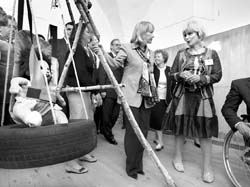Rights of the strong
What can we do for children who are challenged by destiny?
Unfortunately it’s a long way to a truly noble goal, and it takes a lot of steps. “Right to Joy — An Exhibit for Children Challenged by Destiny,” which just opened at the Center for Contemporary Art next to Kyiv MohylaAcademy, is one of those crucial steps.
The goal of the exhibit is to provide a life of dignity for our most vulnerable fellow citizens, people with limited possibilities — those whom we usually call invalids.
An acquaintance of mine told me recently that one of her strongest impressions from her trip to the US was the huge numbers of invalids on the streets. She was constantly encountering people in wheelchairs or with guides and couldn’t stop wondering how sick that country was, with all those handicapped people. Only later did she realize that the US doesn’t have more of them than Ukraine (or fewer). The difference is they don’t sit around at home, but act as full-fledged and competent citizens of their country-and they have every reason to feel this way.
One of the most important aims of the “Right to Joy” exhibit is to help our handicapped population out of their apartment-”reservations” into which they have been herded by an indifferent, and often even hostile, society. Although the exhibit does not offer any set recipe, it shows the different means by which one can reach this goal. The exhibit was organized by various institutions in Sweden, long considered a model country for its care of handicapped people (see The Day, May 19, 2006).
The exhibit has a rich and interesting history. First initiated by the Swedish Institute for Problems of the Handicapped, it was called “The Children’s Train.” Four fully stocked train cars equipped with special wheelchair ramps set out on a journey throughout the Swedish kingdom. The train made 11 stops, and the exhibit was seen by a total of 11,000 people. It even made a stop at the Swedish parliament, the Rijksdag. It was something to see the deputies turning into children and trying out all the toys. Since then the exhibition has visited Brussels, St. Petersburg, and the Baltic countries, Poland, Greece, the Paralympics in Turin, and now Kyiv.
“Right to Joy” is moving because visitors are not prevented from getting up close. You can touch everything, pull all the strings, and lift all the latches. The organizers invite people to take part in this game, because this is not just an exhibit of achievements. It is an attempt to show people who consider themselves healthy what it feels like to live in a world defined by limitations. Such details, as a puppet made to look like a child with Down ‘s syndrome, sitting in a toy carriage, are memorable. For a child with movement disorders the best possible rehabilitation is to have a toy friend that may understand all his problems better than adults.
There are many different kinds of toys on display. Some are “smart toys”, i.e., high-tech gadgets, while others are just beautiful. Visitors had an opportunity to examine an amazing puppet that laughs after applause, computer heroes that actively communicate with the user sitting in front of a monitor, and “croco- chaffinches” that fly on long strings.
These toys are only a small part of what you can offer handicapped children without much effort. There are many small items that not only make life easier but help children obtain a full-fledged education and development: sound calculators that voice every completed operation, special computer keyboards, and control panels with sounds that prompt the user about what to do at specific times — sleep, brush teeth, have dinner. There are also special knives and forks, very comfortable wheelchairs for all kinds of handicaps, and acoustic apparatuses. There were countless other items on display.
But the most important thing that the exhibit teaches visitors is to realize their rights, including the rights of handicapped individuals as well as the rights of people who are responsible for them — all of us. We enjoy rights that we cannot or do not want to use — the rights of the strong. The best manifestation of a truly strong person is the degree of care and compassion for those who are weaker. Vulnerable and defenseless people feel like full-fledged individuals in strong societies that are built by strong nations.
The Swedes have learned how to be strong, but we have not. We have to start attaining our rights. Otherwise we will remain weak, as we were for many centuries.






